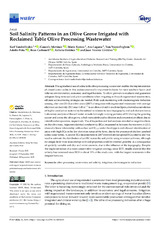Mostrar el registro sencillo del ítem
Soil Salinity Patterns in an Olive Grove Irrigated with Reclaimed Table Olive Processing Wastewater
| dc.contributor.author | Vanderlinden, Karl | |
| dc.contributor.author | Martínez, Gonzalo | |
| dc.contributor.author | Ramos, Mario | |
| dc.contributor.author | Laguna, Ana | |
| dc.contributor.author | Vanwalleghem, Tom | |
| dc.contributor.author | Peña, Adolfo | |
| dc.contributor.author | Carbonell, Rosa | |
| dc.contributor.author | Ordoñez, Rafaela | |
| dc.contributor.author | Giráldez Cervera, Juan Vicente | |
| dc.date.accessioned | 2022-09-28T11:12:58Z | |
| dc.date.available | 2022-09-28T11:12:58Z | |
| dc.date.issued | 2022 | |
| dc.identifier.uri | http://hdl.handle.net/10396/24012 | |
| dc.description.abstract | The agricultural use of saline table olive processing wastewater enables the implementation of closed water cycles in this socioeconomically important industry for rural southern Spain and relieves environmental, economic, and legal burdens. To allow growers to evaluate and guarantee adequate long-term soil and plant conditions when irrigating with such regenerated wastewaters, efficient soil monitoring strategies are needed. Field-scale monitoring with electromagnetic induction sensing, after one (2013) and five years (2017) of irrigation with regenerated wastewater with average electrical conductivity (EC) near 6 dS m−1 in an olive orchard in southern Spain, showed accumulation of highly conductive material in the subsoil in relation to local topography and soil characteristics. Laboratory analysis of the soil water revealed strongly varying patterns of EC during the growing season and across the olive grove, which were attributed to dilution and concentration effects due to rainfall and evaporation, respectively. Visual inspection and leaf analyses revealed no negative effects on the olive trees. Apparent electrical conductivity (ECa), measured in between the tree rows in 2013, showed a linear relationship with surface soil EC1:5 under the drippers and allowed identification of areas with high ECa in the low elevation zones of the farm, due to the presence of shallow perched saline water tables. A second ECa measurement in 2017 showed similar spatial ECa patterns and was used to estimate the distribution of soil EC across the soil profile using inversion software, although no unique field-wide relationships with soil properties could be inferred, possibly as a consequence of spatially variable soil clay and water contents, due to the influence of the topography. Despite the implementation of a more conservative irrigation strategy since 2015, results showed that the salinity has increased since 2013 in about 15% of the study area, with the largest increments in the deepest horizons. | es_ES |
| dc.format.mimetype | application/pdf | es_ES |
| dc.language.iso | eng | es_ES |
| dc.publisher | MDPI | es_ES |
| dc.rights | https://creativecommons.org/licenses/by/4.0/ | es_ES |
| dc.source | Water, 14(19), 3049 (2022) | es_ES |
| dc.subject | Olive processing wastewater | es_ES |
| dc.subject | Soil salinity | es_ES |
| dc.subject | Irrigation | es_ES |
| dc.subject | Electromagnetic induction | es_ES |
| dc.title | Soil Salinity Patterns in an Olive Grove Irrigated with Reclaimed Table Olive Processing Wastewater | es_ES |
| dc.type | info:eu-repo/semantics/article | es_ES |
| dc.relation.publisherversion | https://doi.org/10.3390/w14193049 | es_ES |
| dc.relation.projectID | Gobierno de España. PID2019- 104136RRC21 | es_ES |
| dc.relation.projectID | Gobierno de España. PID2019-104136RR-C22 | es_ES |
| dc.relation.projectID | Junta de Andalucía. AVA2019.018 (IFAPA/ FEDER) | es_ES |
| dc.relation.projectID | Junta de Andalucía. OPO-SE-20-0011 (FEDER) | es_ES |
| dc.rights.accessRights | info:eu-repo/semantics/openAccess | es_ES |

